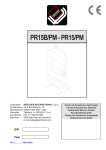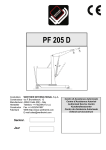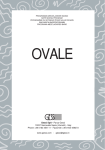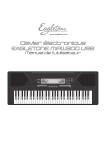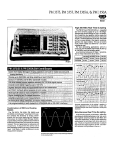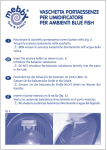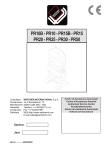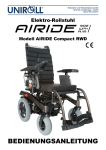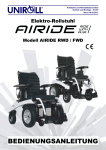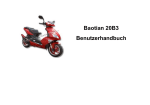Download PR15PM/S - PR20PM/S - PR30PM/S - PR50PM/S
Transcript
PR15PM/S - PR20PM/S - PR30PM/S PR50PM/S Costruttore Constructeur Manufacturer Hersteller Constructor Fabrikant WERTHER INTERNATIONAL S.p.A. via F.Brunelleschi, 12 42040 Cadè (RE) - Italy Telefono ++/+522/9431 (r.a.) Fax ++/+522/941997 WEB http://web.tin.it/werther E-mail [email protected] Rev.2 .............11/04/2005 Centro di Assistenza Autorizzato Centre d’Assistance Autorisé Authorized Service Centre Kundendienstcenter Centro de Asistencia Autorisado Geautoriseerde dealer 6 Ritorno pistone Retour piston Ram return Kolbenrueckzug Retorno pistón Azionamento pistone Descente piston Ram operation Kolbenbetaetigung Accionamiento pistón Descrizione 1 Cilindro 2 Valvola di massima pressione 3 Valvola di non ritorno mandata 4 Valvola di non ritorno mandata 5 Valvola di regolazione scarico 6 Valvola regolazione velocita’ 7 Pompa a mano 8 Valvola di non ritorno aspirazione 2 Description Cylinder High pressure safety valve Check valve, delivery side Beschreibung Zylinder Überdruckventil Pistone veloce Vitesse rapide Fast ram Kolben schnell Pistón veloz Pistone lento Vitesse lente Slow ram Kolben langsam Pistón lento Désignation Verin Soupape de surpression Rückschlagve Soupape ntil, vorlauf antiretour, cote refoulement Rückschlagve Soupape Check antiretour, ntil, vorlauf valve, cote delivery side refoulement Ablass-regelve Soupape de Release ntil reglage adjusting decharge valve Geschwindigk Soupape Speed eits-regelventil reglage adjusting vitesse valve Handpumpe Pompe Manual pump manuelle Rückschlagve Soupape Check antiretour valve, inlet ntil, cote retoir ansaugseite side Descripción Cilindro Valvula de maxima presion Valvula de no retroceso (envio) Valvula de no retroceso (envio) Valvula de regulacion descarga Valvula regulacion velocidad Bomba manual Valvula de no retroceso (aspiracion) MANUALE di MANUTENZIONE per PRESSE IDRAULICHE da OFFICINA. I Mod. PR15PM/S - PR20PM/S - PR30PM/S - PR50PM/S RESPONSABILITA’ DEL PROPRIETARIO E/O DELL’UTILIZZATORE DELLA PRESSA Questo manuale è parte integrante della pressa e deve sempre accompagnarla, anche in caso di vendita. Il proprietario e/o l’utilizzatore della pressa devono conoscere le istruzioni d’uso e le raccomandazioni prima dell’utilizzo della pressa. Se l’operatore non capisce bene la lingua del presente manuale, le istruzioni devono essere lette e spiegate nella sua lingua madre assicurandosi che ne comprenda il significato. Il costruttore non risponde di alcun danno a persone o a cose per uso improprio o non consentito della pressa. IMBALLAGGIO La pressa viene spedita in un solo collo protetto da materiale plastico pluriball. Pesi delle presse: Mod. PR15PM/S PR20PM/S PR30PM/S PR50PM/S Kg. 180 208 390 375 SOLLEVAMENTO E MOVIMENTAZIONE Le presse devono essere movimentate e posizionate servendosi di muletti sollevatori o gru da officina che sopportino il peso. STOCCAGGIO Gli imballi devono essere conservati in luoghi coperti e protetti, a temperature comprese fra -10° e +40°C. SICUREZZA Non usare la pressa per scopi diversi da quelli per cui è stata progettata. Non lavorare accanto ai pezzi mentre il pistone è in movimento o quando lo stesso è sotto pressione. La valvola di sicurezza è tarata e sigillata dal costruttore: NON TENTARE DI MANOMETTERLA E DI VARIARE LA TARATURA. LA MANCANZA del RISPETTO di queste RACCOMANDAZIONI può causare danni anche gravi alla pressa e/o alle persone. IL COSTRUTTORE NON RISPONDE DI DANNI A PERSONE OD OGGETTI CAUSATI DA UN USO IMPROPRIO DELLA PRESSA O DEI SUOI COMPONENTI. MONTAGGIO (• operazioni per tutti i tipi di presse - n operazioni solo per certi tipi di presse) · Togliere la pressa dall’involucro di pluriball verificando che la macchina non abbia subito danni durante il trasporto e che siano presenti tutti i pezzi indicati nella lista di spedizione. Il materiale dell’imballo deve essere smaltito secondo le norme vigenti in vigore nel paese in cui la pressa viene montata oppure riciclato o riutilizzato. · Posizionare la pressa su una superficie piana e ben livellata. All’interno dei piedi si trovano due fori per un’eventuale fissaggio a terra da effettuarsi mediante tasselli ad espansione di buona sezione. n Solamente per PR15PM/S e PR20PM/S: Montare i piedi al corpo della pressa avvitandoli con le viti e i dadi forniti (fig.1) quindi fissare la pressa ad un banco piano di portata idonea (vedi pesi presse), bloccandola mediante bulloni passanti e dadi, al banco di lavoro. 3 Solamente per PR30PM/S e PR50PM/S: Svitare la maniglia del vericello che, per comodità di imballo, viene fornita rovesciata; quindi avvitarla correttamente bloccandola con una chiave (fig. 2). n Ingrassare leggermente i perni del vericello. · Stendere un leggero velo di olio sui perni di sostegno del banco da lavoro della pressa. n ISTRUZIONI PER L’USO · Posizionare il bancale della pressa (rif.1, fig.6) all’altezza desiderata, sollevandolo prima da una parte ed inserendo una delle spine (rif. 2 , fig.6) nel foro del corpo pressa immediatamente sotto, quindi ripetendo l’operazione per l’altra parte. n Solamente per presse mod. PR30PM/S e PR50PM/S: azionare il vericello della pressa così da sollevare il bancale. n Posizionare le spine (rif. 2 , fig.6) nel punto voluto. n Muovere leggermente il vericello così da sganciare il dente di tenuta. Sollevare il dente con un dito (fig.3) portandolo in posizione verticale e contraria rispetto alla ruota dentata del vericello quindi lasciar scendere il bancale trattenendo la leva del vericello. n Lasciare il dente che si riposizionerà da solo alla successiva operazione sul vericello. IATTENZIONE NON MANOVRARE MAI IL VERICELLO CON LE DITA VICINO ALLA RUOTA DENTATA. É ASSOLUTAMENTE VIETATO OPERARE CON IL BANCALE SOSPESO DALLE FUNI DEL VERICELLO: TUTTE LE OPERAZIONI DI LAVORO SONO DA COMPIERSI CON IL BANCALE APPOGGIATO SULLE SPINE ED IL VERICELLO COMPLETAMENTE LIBERO. Posizionare i prismi (rif.3, fig.6) sul Bancale (rif.1, fig.6). Inserire la leva della pompa (rif.4, fig.6) nella relativa sede (rif.5, fig.6) della pompa stessa. In fig.7 sono indicati gli usi relativi alle posizioni delle due manopole poste sulla pompa. Azionare la leva per far discendere il pistone, eseguire il lavoro quindi riportare il pistone a riposo azionando la manopola relativa (fig.7). La leva di azionamento della pompa è libera così da poterla sfilare o spostare nel caso infastidisse le operazioni di lavoro sulla pressa. · · · · MANUTENZIONE · Oliare le parti in movimento della pressa ogni sei mesi e verificare il funzionamento del manome- tro. Ogni sei mesi ingrassare i vericello e le sue funi. Queste ultime dovranno essere controllate visivamente ed eventualmente sostituite se dovessero presentare rotture o difetti. · L’unità idraulica (cilindro/pompa) è un sistema sigillato che in condizioni normali richiede solo una lubrificazione semestrale dei pezzi mobili. Nel caso in cui l’unità idraulica perda olio e venga smontata per la sostituzione delle guarnizioni, sarà necessario aggiungere olio attraverso il foro di riempimento posto sulla pompa (rif.6, fig.5), fino a riempire la pompa a livello del foro stesso. Kg di Questa operazione deve essere fatta con pistone a riposo pertanto Modello olio completamente rientrato. L’olio nell’unità idraulica va comunque sostituito ogni due anni indipendentemente dalle condizioni generali PR15PM/S 1,2 dell’unità stessa. PR20PM/S Usare olio idraulico con viscosità da 22° a 25°. PR30PM/S Nella tabella a lato viene indicata la quantità di olio necessaria ad ogni 2,3 PR50PM/S tipo di pressa. n Una quantità maggiore d’olio potrebbe causare inconvenienti. IATTENZIONE Non usare MAI olio per freni. 4 INFORMAZIONI PARTICOLARI · L’olio esausto prelevato dalla pressa deve essere smaltito secondo le leggi vigenti nel paese di installazione della macchina. · In caso di distruzione della pressa, tutte le parti metalliche sono riciclabili; i tubi in gomma e i fluidi della pressa devono essere eliminati secondo le leggi vigenti nel paese di installazione della pressa. 5 MANUEL D’UTILISATION ET D’ENTRETIEN pour les PRESSES HYDRAULIQUES D’ATELIER F Mod. PR15PM/S - PR20PM/S - PR30PM/S -PR50PM/S RESPONSABILITE DU PROPRIETAIRE ET/OU DE L’UTILISATEUR DE LA PRESSE Ce manuel fait partie intégrante de la presse et doit toujours l’accompagner, même en cas de revente. Le propriétaire et/ou l’utilisateur de la presse doit connaître les instructions et les recommandations d’emploi avant de se servir de la presse. Si l’opérateur ne comprend pas la langue dans laquelle est rédigé ce manuel, les instructions devront lui être Iues et expliquées dans sa langue maternelle en s’assurant que celles-ci soient bien comprises. Le constructeur décline toute responsabìlité relative aux dommages qui pourraient être causés aux personnes et aux biens par suite d’une utilisation de la presse incorrecte et non appropriée. EMBALLAGE Les presses sont expédiées en un seul colis, protégées par un film plastique multi-bulles. Poids des presses: Mod. PR15PM/S PR20PM/S PR30PM/S PR50PM/S Kg. 180 208 390 375 MANUTENTION ET DEPLACEMENT Les presses doivent toujours être déplacées et positionnées au moyens de chariots à fourches ou de grues d’atelier pouvant en supporter le poids. STOCKAGE Les presses devront être conservées emballées dans des endroits couverts et protégés, à des températures comprises entre -10°C et +40°C. SECURITE Ne pas utiliser la presse pour d’autres usages que ceux pour lesquels elle a été conçue. Ne pas travailler sur les pièces à presser lorsque le piston est en mouvement ou sous pression. La soupape de sécurité est tarée et plombée par le constructetur: NE PAS TENTER DE LA DEMONTER OU D’EN MODIFIER LE REGLAGE. Le NON-RESPECT de ces RECOMMANDATIONS peut causer les dommages, mêmes graves, à la personne et/ou personnes qui travaillent avec la presse. LE CONSTRUCTEUR DECLINE TOUTE RESPONSABILITE RELATIVE AUX DOMMAGES QUI POURRAIENT ÊTRE CAUSES AUX PERSONNES OU AUX BIENS PAR SUITE D’UNE UTILISATION IMPROPRE DE LA PRESSE OU DE SES ACCESSOIRES. MONTAGE (• opérations concernant toutes les presses - n opérations concernant seulement certains modèles) · Enlever la presse de son emballage multi-bulles en vérifiant qu’elle n’ait subit aucun dommage en cours de transport et qu’il ne manque aucun des éléments mentìonnés sur le bordereau de colisage. Les matériaux d’emballage devront être soit éliminés selon les normes en vigueur dans le pays où la presse est installée, soit recyclés ou réutílisés. · Positionner la presse sur un surface plane et horizontale. A l’intérieur des pieds sont pratiqués deux trous permettant l’ancrage éventuel de la presse sur le sol au moyen de chevilles à expansion de dimension adéquate. n Seulement pour PR15PM/S et PR20PM/S: Monter les pieds sur le bâti de la presse au moyen des boulons fournis (fig.1) et la fixer ensuite, à l’aide de boulons traversants, sur le plateau d’un établi suffisamment robuste pour en supporter le poids. 6 Seulement pour PR30PM/S et PR50PM/S: Dévisser la manivelle du treuil, qui, pour le transport, est montée à l’envers. La revisser dans le sens correct et serrer à l’aide d’une clé (fig.2). n Graisser légèrement les axes du treuil. · Appliquer un léger- voile d’huile sur les broches soutenant la table de la presse. n INSTRUCTIONS D’EMPLOI · Positionner la table de la presse (réf.1, fig.6) à la hauteur désirée, en soulevant d’abord une ex- trémité et en insérant la broche (réf.2, fig.6) dans le trou du bâti immédiatement en dessous puis répéter l’opération pour l’autre extrémité. n Seuleument pour les presses PR30PM/S et PR50PM/S: actionner le treuil de la presse de façon à élever la table. n Placer les boches (réf.2, fig.6) à la hauteur voulue. n Tourner légèrement la manivelle du treuil de façon à dégager le clìquet de retenue. Soulever le crochet avec un doigt (fig.5) et le placer en position verticale à l’opposé de la roue dentée du treuil puis laisser descendre doucement la table sur les broches (réf.2, fig.6) en retenant la manivelle. n Relacher le crochet qui se replacera automatiquement pour la prochaine utilisation du treuil. IATTENTION NE JAMAIS MANOEUVRER LE TREUIL AVEC LES DOIGTS PRES DE LA ROUE DENTEE. IL EST ABSOLUMENT INTERDIT D’UTILISER LA PRESSE LORSQUE LA TABLE EST SUSPENDUE AUX CABLES DU TREUIL: TOUTES LES OPERATIONS DE PRESSAGE DOIVENT ÊTRE EFFECTUEES AVEC LA TABLE EN APPUI SUR LES BROCHES ET LE TREUIL COMPLETEMENT LIBERE. · Positionner les vés (réf.3, fig.6) sur la table (réf.1, fig.6) · Introduire le levier de la pompe (réf.4, fig.6) dans son support (réf.5, fig.6) sur le haut de la pom- pe. · En Fig.7 sont indiquées les fonctions des deux robinets situés sur la pompe. · Actionner le levier plusieurs fois de haut en bas pour faire descendre le piston, actionner ensuite le robinet situé sur la pompe (fig.7) pour obtenir le retour du piston à sa position initiale. Le levier de la pompe est libre de façon à pouvoir s’enlever ou se déplacer dans le cas où il gênerait les opérations de travail autour de la presse. ENTRETIEN · Huiler les parties en mouvement tous les six mois et contrôler le bon fonctionnement du ma- nomètre. n Tous les six mois, graisser le treuil et les cables. Ces derniers devront être contrôlés visuellement sur toute leur longueur et remplacés s’il présentent le moindre défaut. · L’unité hydraulique (pompe/vérin) est un système fermé qui, en utilisation normale, ne demande qu’une lubrification semestrielle des parties mobiles. Dans le cas ou l’unité hydraulique présenterait une fuite d’huile et serait démontée pour remplacement des joints, il Kg Modèle sera nécessaire de refaire le plein d’huille au travers de l’orifice de remhuile plissage situé sur la pompe (réf.6, fig.5) jusqu’à ce que le niveau de PR15PM/S 1,2 l’huile atteigne le bord de l’orifice. Cette opération doit être faite avec le PR20PM/S piston du vérin en position de repos, c’est à dire complètement PR30PM/S rentré. L’huile de l’unité hydraulique doit, de toutes façons, être rem2,3 PR50PM/S placée tous les deux ans, quel que soit l’état de l’unité hydraulique. Utiliser de l’huile hydraulique de viscosité 22°E à 25°E Le tableau ci-contre indique la quantité d’huile nécessaire pour chaque modèle de presse. Une quantité supérieure peut nuire au bon fonctionnement de la presse. IATTENTION Ne JAMAIS utiliser du liquide de freins! 7 INFORMATIONS PARTICULIERES · L’huile usagée provenant de la presse doit être éliminée en conformìté avec les normes en vi- gueur dans le pays où est installée la presse. · En cas de destruction de la presse, toutes les parties métalliques sont recyclables, le canalisations en caoutchouc et les fluides contenus dans la presse devront être éliminés en conformité avec les normes en vigueur dans le pays où est installée la presse. 8 GB MAINTENANCE MANUAL for WORKSHOP HYDRAULIC PRESSES Mod. PR15PM/S - PR20PM/S - PR30PM/S - PR50PM/S 1) LIABILITY OF PRESS OWNER AND/OR USER This manual is an integral part of the press and must always accompany it, even in the event of sale. The press owner and/or user must know the operating instructions and recommendations before using the press. If the operator does not fully understand the language of this manual, the instructions have to be read and explained in his or her native language making sure the meaning is understood. The manufacturer shall not be held liable for any damage to persons or objects due to an improper or non-permitted use of the press. PACKING The press is shipped in a single pack protected by pluriball plastic material. Weights of presses: Mod. PR15PM/S PR20PM/S PR30PM/S PR50PM/S Kg. 180 208 390 375 LIFTING AND HANDLING The presses have to be handled and positioned using fork-lift trucks or workshop cranes that support the weight. STORAGE The packing has to be kept in a covered and sheltered place at a temperature between -10°C and +40°C. SAFETY Do not use the press for purposes other than those for which it was designed. Do not work alongside pieces while the ram is moving or when it is under pressure. The safety valve is calibrated and sealed by the manufacturer: DO NOT ATTEMPT TO TAMPER WITH IT AND CHANGE THE SETTING. FAILURE to OBSERVE these RECOMMENDATIONS may cause even serious damage to the press and/or to the persons working with it. THE MANUFACTURER SHALL NOT BE HELD LIABLE FOR DAMAGE TO PERSONS OR THINGS CAUSED BY IMPROPER USE OF THE PRESS OR OF ITS COMPONENTS. ERECTION (• operations for all types of presses - n operations only for certain types of presses) · Take the press out of it pluriball wrapping, checking that the machine has not been damaged during transport and that there are all the pieces indicated in the packing list. The packing material has to be disposed of in compliance with the regulations in force in the country where the press is being erected or recycled or reused. · Position the press on a flat and fully levelled surface. Inside the feet there are two holes for fixing to the ground by using expansion plugs of a large cross-section. n Only for PR15PM/S and PR20PM/S:Fit the feet to the body of the press by screwing them on with the nuts and bolts supplied (Fig. 1). Then fix the press to a solid bench of a suitable capacity load (see press weights), locking it by means of through bolts and nuts to the workbench. n Only for PR30PM/S and PR50PM/S: Unscrew the winch handle that, for packing convenience, is supplied upturned; then screw it on correctly, locking it with a spanner (Fig. 2). 9 Lightly grease the winch pins. · Spread a thin film of oil on the press workbench support pins. n OPERATING INSTRUCTIONS · Position the bed of the press (ref.1, fig.6) at the desired height, lifting it first on one side and inser- ting one of the pins (ref.2, fig.6) into the hole in the press body directly beneath, then repeating this step for the other side as well. n Only for PR30PM/S and PR50PM/S mod. presses: operate the press winch in order to lift the bed. n Position the pins (ref.2, fig.6) at the desired point. n Move the winch slightly to unhook the seal tooth. Lift the tooth with a finger (Fig. 3) bringing it into an upright position and contrary with respect to the winch gear wheel, then let the bed come down by holding back the winch lever. n Release the tooth that will position itself at the next operation on the winch. I WARNING NEVER OPERATE THE WINCH WITH FINGERS CLOSE TO THE GEAR WHEEL. IT IS ABSOLUTELY FORBIDDEN TO OPERATE WITH THE BED HANGING BY THE ROPES OF THE WINCH: ALL WORK OPERATIONS ARE TO BE MADE WITH THE BED RESTING ON THE PINS AND THE WINCH ENTIRELY FREE. Position the prisms (ref.3, fig.6) on the bed (ref.1, fig.6). Insert the lever of the pump (ref.4, fig.6) into its relative seat (ref.5, fig.6) on the pump. Fig. 7 shows the uses relative to the positions of the two dials on the pump. Operate the lever to lower the ram, carry out the work then bring the ram back to rest with the relative dial (Fig. 7). The pump operating lever is thereby free to be able to be extracted or moved if it gets in the way of work on the press. · · · · MAINTENANCE · Oil the moving parts of the press every six months and check operation of the pressure gauge. Every six months, grease the winch and its ropes. These ropes will have to be inspected visually and possibly replaced if they are broken or defective. · The hydraulic unit (cylinder/pump) is a sealed system that in normal conditions requires only sixmonthly lubrication of the moving parts. In the event of the hydraulic unit leaking oil and being dismantled in order to replace the seals, it will be necessary to add oil through the filler hole on the pump (ref. 6, Fig. 5) until the pump has been filled up to the level of the hole itself. This operation has to be done with the ram at rest and therefore fully retracted. The oil in the hydraulic units should anyhow be replaced every two years independently of the general conditions of the unit. Use hydraulic oil with viscosity from 22° to 25°. n The table shown here gives the quantity of oil needed for each type of press. A greater amount of oil could cause trouble. IWARNING NEVER use brake oil. 10 Model Kg of oil PR15PM/S PR20PM/S 1,2 PR30PM/S PR50PM/S 2,3 SPECIAL INFORMATION · The waste oil taken from the press has to be disposed of in compliance with the laws in force in the country where the machine is installed. · If the press is to be destroyed, all the metal parts can be recycled; the rubber hoses and the press fluids have to be disposed of in compliance with the laws in force in the country where the machine is installed. 11 WARTUNGSANLEITUNG FUER HYDRAULISCHE WERKSTATTPRESSEN D Mod. PR15PM/S - PR20PM/S - PR30PM/S - PR50PM/S VERANTWORTLICHKEIT DES EIGENTUEMERS UND / ODER DES ANWENDERS VON PRESSEN Diese Anleitung muss dem Artikel immer beigelegt sein, auch bei Verkauf. Der Eigentuemer/Anwender muss sich vor Inbetriebnahme der Presse mit der Gebrauchsanweisung vertraut machen und die Hinweise beachten. Wenn der Anwender die Anleitung in der jeweils geschriebenen Sprache nicht versteht, muss diese ihm in seiner Sprache erklaert werden, so dass der Sinn verstanden wird. Der Hersteller haftet fuer keine Personen- und Sachschaeden bei nicht sachgemaesser Handhabung. VERPACKUNG Die Presse wird als ein Kolli verschickt und in gepolsterte Plastikfolie verpackt. Gewicht der Pressen: Mod. PR15PM/S PR20PM/S PR30PM/S PR50PM/S Kg. 180 208 390 375 HEBEN UND BEWEGUNG Die Pressen muessen mit einem Gabelstabler oder Werkstattkran bewegt und positioniert werden, die das Gewicht aushalten. LAGERUNG Die Verpackungen muessen in geschuetzten Raeumen, bei Temperaturen zwischen -10° und +40°C. gelagert werden SICHERHEIT Die Pressen nur fuer den ihr vorgesehenen Zweck verwenden. Nicht nebenbei an Teilen arbeiten, wenn der Kolben in Bewegung ist, oder unter Druck steht. Das Sicherheitsventil ist vom Hersteller eingestellt: NIEMALS VERSUCHEN, DASS VENTIL ZU VERSTELLEN. DAS NICHTEINHALTEN dieser HINWEISE kann grosse Schaeden an der Presse oder an Personen verursachen. DER HERSTELLER HAFTET FUER KEINERLEI PERSONEN - UND SACHSCHAEDEN BEI UNSACHGEMAESSER HANDHABUNG MONTAGE (·Operation fuer alle Pressentypen - n Operationen nur fuer bestimmete Pressentypen) · Die Presse vom Plastik befreien und ueberpruefen, ob die Presse Transportschaeden aufweist oder Teile fehlen. Das Verpackungsmaterial muss gemaess der landesueblichen Umweltgesetze entsorgt werden. · Die Presse auf einen ebenen Boden stellen. Im Innern des Fusses finden sich zwei Loecher, die zur Befestigung mit Duebeln in den Boden dienen. n Nur fuer PR15PM/S und PR20PM/S: Die Fuesse an den Pressenkoerper mit den beigefuegten Schrauben und Muttern (Fig.1) anbringen.Dann die Presse an eine ebene Ablage anbringen, die eine geeignete Tragkraft (siehe Pressengewichte) aufweist, diese mit Bolzen und Muttern an der Arbeitsablage festmachen. n Nur fuer PR30PM/S und PR50PM/S: Den Handgriff des Handrades abschrauben (aus Transportgruenden wird der Griff umgekehrt angebracht. Demnach den Griff richtig anbringen und mit einem Schluessel festziehen. (Abb.2) 12 Den Stift des Handrades leicht einfetten · Einen leichten Oelfilm auf den Unterstuetzungsstift der Arbeitsablage der Presse schmieren. n GEBRAUCHSANWEISUNG · Das Bett der Presse (ref.1, Abb.6) auf die gewuenschte Hoehe bringen, dabei erst eine Seite he- ben und einen der Stifte (ref.2, Abb.6) in das Loch des Pressenkoerpers, dass sich darunter befindet, einfuehren. Dann diesen Vorgang mit der anderen Seite durchfuehren. n Nur fuer Pressen Modell PR30PM/S und PR50PM/S. Das Handrad der Presse betaetigen, um das Bett zu heben. n Die Stifte (ref.2, Abb.6) in dem gewuenschten Punkt anbringen. n Leicht das Handrad bewegen, um den Dichtungszahn zu loesen. Den Zahn mit einem Finger (Abb.3) heben und ihn dabei in horizontale Position bringen. Dann das Bett herunterlassen und dabei den Hebel des Handrades festhalten. n Den Zahn loslassen, so dass er sich von selbst wieder positioniert. IACHTUNG DAS HANDRAD NIEMALS BETAETIGEN, WENN SICH DIE FINGER IN DER NAEHE DES ZAHNRADES BEFINDEN. ES IST UNTERSAGT, DAS BETT ZU BETAETIGEN, WENN DIE SEILE NICHT AM HANDRAD ANGEBRACHT SIND: ALLE ARBEITSSCHRITTE SIND SO DURCHZUFUEHREN, DASS DAS BETT AN DEN STIFTEN ANGELEHNT IST UND DAS HANDRAD VOELLIG FREI IST. · Die Prismen auf dem Bett (ref.1, Abb.6) positionieren (ref.3, Abb.6) · Den Hebel der Pumpe (ref.4, Abb.6) in den dafuer vorgesehenen Sitz einfuehren (ref.5, Abb.6) · In Abb.7 sind die jeweiligen Anwendungen, wie die zwei Griffe an der Pumpe angebracht wer- den, aufgefuehrt. · Den Hebel betaetigen, um den Kolben herunter zu fahren, die Arbeit durchfuehren und dann den Kolben wieder in die Ruhestellung bringen, indem der jeweilige Drehknopf betaetigt wird (Abb.7) Der Betaetigungshebel der Pumpe ist frei, dadurch kann er herausgenommen oder verrueckt werden, sofern er die Arbeitsschritte an der Presse behindert. WARTUNG · Die sich bewegenden Teile alle sechs Monate oelen und ueberpruefen, ob das Manometer funk- tioniert. n Alle sechs Monate das Handrad und dessen Seile oelen. Die Letzteren muessen einer Sichtkontrolle unterzogen werden und bei evtl. Defekten ausgetauscht werden. · Die Hydraulikeinheit (Zylinder/Pumpe) ist ein versiegeltes System. Im Normalfall muessen die beweglichen Teile alle sechs Monate geschmiert werden. Sollte die Hydraulikeinheit Oel verlieren und die Dichtungen dieser ausgetauscht werden sollen, ist es notwendig, Oel durch das Auffuelloch ,das auf der Pumpe (Ref 6, Abb 6) sitzt, hinzuzufuegen. Dieses muss ganz gefuellt sein. Diesen Vorgang nur mit Kolben in Ruheposition, also wenn er ganz eingefahren ist, durchfuehren. Das Oel in der Hydraulikeinheit alle zwei Jahre, unabhaengig vom Zustand der Einheit, austauschen. Model Oel Kg Oel mit einer Viskositaet von 22° bis 25° verwenden In der nebenstehenden Tabelle wird die noetige Oelmenge fuer jeden Pressentyp angegeben. Eine erhoehte Oelmenge kann Stoerungen verursachen. PR15PM/S PR20PM/S 1,2 PR30PM/S PR50PM/S 2,3 IACHTUNG Niemals Bremsoel verwenden 13 BESONDERE INFORMATIONEN · Das Altoel der Pressen muss gemaess der landesueblichen Umweltgesetze entsorgt werden. · Sollte die Presse vernichtet werden: Alle Metallteile sind wiederverwertbar; die Gummischlaeu- che und die Fluessigkeiten der Presse muessen gemaess der landesueblichen Gesetze entsorgt werden. 14 15 t PM/S 20 t PM/S 4 30 t PM/S 50 t PM/S 5 R1182 R1226 R1178 R1179 R1225 R1247 7 Part Code A0231 A0315 A0346 B0370 B0639 B0920 B1094 B2209 B2847 C0062 C0519 R0046 R0071 R0072 R0087 R0093 R0094 R0100 R0120 R0132 R0140 R0141 R0173 R0174 R0177 R0178 R0182 R0183 R0186 R0187 R0190 R0207 R0208 R0209 R0212 R0213 R0214 R0221 R0222 R0223 R0226 R0227 R0228 R0229 R0264 R0266 R0274 R0275 R0276 8 Sugg Descrizione DADO ALTO M10 6S UNI 5587 ZB DADO ALTO M12 ZINCATO RONDELLA P 12 X 24 UNI 6592 RONDELLA Ø14X28 UNI 6592 DISTANZIALE VITE TE M12X50 UNI 5739 VITE TE M14X110 UNI 5737 VITE TE M10X70 UNI 5737 DADO BLOCK B. M10 UNI 7474 RONDELLA Ø10,5X21 UNI 6592 RACCORDO “L” M 3/8" DADO MEDIO M12 UNI 5588 SUPPORTO V SUPPORTO V VERICELLO COMPLETO SPINA D 25X320 SPINA D 30X340 CORPO POMPA A MANO VOLANTINO 6 LOBI MA8X50 RONDELLA RAME 3/8" VITE TE M12X90 UNI 5737 ZB PULEGGIA VERICELLO SEEGER E50 UNI 7435 KIT GUARNIZIONI SEEGER E60 UNI 7435 KIT GUARNIZIONI SEEGER E80 UNI 7435 MOLLA PISTONE KIT GUARNIZIONI MOLLA PISTONE KIT GUARNIZIONI BUSSOLA GUIDA CILINDRO TESTATA PISTONE TAPPO+GRANO 8X10 BUSSOLA GUIDA CILINDRO TESTATA PISTONE TAPPO+GRANO 8X10 PISTONE BUSSOLA GUIDA CILINDRO TESTATA PISTONE PISTONE BUSSOLA GUIDA CILINDRO TESTATA PISTONE TAPPO+GRANO 8X10 PIEDE DISTANZ.SCORREVOLE MANOPOLA 15-20 DISTANZIALE 15-20 MORSETTO CAVETTO D5 15-20 Description ECROU HAUT M10 6S UNI 5587 ZB ECROU HAUT M12 UNI 5587 RONDELLE Ø13X24 UNI 6592 RONDELLE PLATE Ø14X28 UNI 6592 ENTRETOISE VIS TH M12 X 50 UNI 5739 VIS TH M14 X 110 UNI 5737 VIS TH M10 X 70 UNI 5737 ÉCROU FREIN M 10 UNI 7474 RONDELLE Ø10,5X21 UNI 6592 RACCORD EN “L” M/M 3/8" ECROU M12 UNI 5588 SUPPORT EN “V” SUPPORT EN “V” TREUIL COMPLET GOUPILLE Ø 25 X 320 MM. GOUPILLE Ø 30 X 340 MM. CORPS DE POMPE MAN. MOLETTE RONDELLE 3/8" UNI 7989 VIS TH M12 X 90 UNI 5737 POULIE DE TREUIL CIRCLIPS E50 UNI 7435 JEU DE JOINTS CIRCLIPS E60 UNI 7435 JEU DE JOINTS CIRCLIPS E80 UNI 7435 RESSORT DE PISTON JEU DE JOINTS RESSORT DE PISTON JEU DE JOINTS BAGUE-GUIDE PISTON EMBOUT DE VÉRIN BOUCHON + VIS (8X10 UNI 5923) BAGUE-GUIDE PISTON EMBOUT DE VÉRIN BOUCHON + VIS (8X10 UNI 5923) PISTON BAGUE-GUIDE PISTON EMBOUT DE VÉRIN PISTON BAGUE-GUIDE PISTON EMBOUT DE VÉRIN BOUCHON + VIS (8X10 UNI 5923) PIED ENTRETOISE POIGNÈE ENTRETOISE SERRE-CÂBLE R0285 R0467 R0469 R0470 R0471 R0474 R0478 R0479 R0666 R1153 R1154 R1155 R1157 R1158 R1160 R1161 R1162 R1164 R1166 R1167 R1168XX R1169XX R1173 R1174 R1175 R1176 R1177 R1178 R1179 R1182 R1214 R1215 R1216 R1217 R1218 R1219 R1220XX R1221 R1222 R1223 R1224 R1225 R1226 R1245XX R1246 R1247 R1248 R1249 R1250 R2095 TAPPO+GRANO 8X10 KIT VARIATORE POMPA A MANO KIT VALV. ASP.-COMP. ALTA PRES KIT VALVOLA DI MASSIMA POMPA KIT VALV. ASP.-COMP. BASSA PRE KIT BIELLA POMPA+FLANGIA KIT POMPANTE POMPA KIT POMPANTE POMPA A MANO VITE TE M12X35 UNI 5739 ZB PIANO DI LAVORO MANOMETRO Ø 63 MM. VOLANTINO VALVOLA DI SCARICO TUBO MANDATA OLIO TUBO MANOMETRO ATTACCO LEVA POMPA A MANO PIANO DI LAVORO CANNA CILINDRO CANNA CILINDRO PISTONE PISTONE TELAIO TELAIO KIT VALVOLA DI SCARICO CARTER POMPA LEVA COMANDO POMPA A MANO MOLLA PISTONE MOLLA PISTONE CILINDRO COMPLETO CILINDRO COMPLETO POMPA COMPLETA TUBO MANDATA OLIO PIANO DI LAVORO CORPO POMPA A MANO CANNA CILINDRO CANNA CILINDRO PEDALE TELAIO KIT VALVOLA DI SCARICO BIELLA PER PEDALE CARTER POMPA MOLLA RICHIAMO PEDALE CILINDRO COMPLETO POMPA COMPLETA TELAIO DISTANZ.SCORREVOLE CILINDRO COMPLETO TUBO MANDATA OLIO SPINA D 35X380 PIANO DI LAVORO DADO M14 UNI 5588 BOUCHON + VIS (8X10 UNI 5923) ENSEMBLE CHANGEUR DE VITESSE ENSEMBLE VALVE ASP./REF. H.P. ENSEMBLE VALVE DE SURPRESSION ENSEMBLE VALVE ASP./REF. B.P. ENSEMBLE FLASQUE + BIELLE ENSEMBLE PISTON ENSEMBLE PISTON VIS TH M12X35 UNI 5739 TABLE DE TRAVAIL MANOMÈTRE Ø 63 MM. MOLETTE VALVE DE DECHARGE TUBE DE REFOULEMENT D’HUILE TUBE MANOMÈTRE FIXATION LEVIER DE COMMANDE P.M. TABLE DE TRAVAIL CYLINDRE DE VÉRIN CYLINDRE DE VÉRIN PISTON PISTON CHASSIS CHASSIS ENSEMBLE VALVE DE DECHARGE CARTER POMPE LEVIER DE COMMANDE P.M. RESSORT DE PISTON RESSORT DE PISTON VÉRIN COMPLET VÉRIN COMPLET POMPE COMPLETE TUBE DE REFOULEMENT D’HUILE TABLE DE TRAVAIL CORPS DE POMPE MAN. CYLINDRE DE VÉRIN CYLINDRE DE VÉRIN PÉDALE CHASSIS ENSEMBLE VALVE DE DECHARGE BIELLE PÉDALE CARTER POMPE RESSORT DE RAPPEL DE PÉDALE VÉRIN COMPLET POMPE COMPLETE CHASSIS ENTRETOISE VÉRIN COMPLET TUBE DE REFOULEMENT D’HUILE GOUPILLE Ø 35 X 380 MM. TABLE DE TRAVAIL ECROU M14 UNI 5588 9 Z_ZCONS 10 * = RICAMBI CONSIGLIATI * = PIECES DE RECANGE CONSEILLEES Dichiarazione di conformità - Declaration of Conformity Déclaration de conformité - Konformitätserklärung Declaración de conformidad - Declaraçãde conformidade EG-Conformiteitsverklaring - Samsverserklæring Överensstämmande intyg - Overensstemmelseserklæring WERTHER INTERNATIONAL S.p.A. Via F.Brunelleschi, 12 42040 CADE’ (Reggio Emilia) Italy Tel.++/+522/9431 (r.a.) Fax ++/+522/941997 WEB http://web.tin.it/werther E-mail [email protected] con la presente dichiara che - hereby declare that déclare par la presente que - erklären hiermit, daß por la presente declara, que - come a presente declaramos que a verklaren hiermee, dat - Vi erklærer hermed, at autoløfter model Vi erklærer herved, at løftebuk model - Vi förklarer härmed att billyft model Presse idrauliche modelli - Presse hydraulique modèle Hydraulic presses model - Hydraulischen pressen modell Prensas hidráulicas - Prensa modelo De hydraulische werkplaatspers model - Hydraulske presser modell Hydrauliska pressar, modeller - Hydrauliske presser PR15PM/S - PR20PM/S - PR30PM/S - PR50PM/S I sono state costruite in conformità alle normative 98/37/CE were manufactured in conformity with the normes 98/37/CE F a été construite en conformité avec les normes 98/37/CE in Übereinstimmung mit den Richtlinien 98/37/CE D E ha sido fabricado según las disposiciones 98/37/CE fue produzida em conformidade com a norma 98/37/CE P ble produsert i samsvar med direktivene 98/37/CE N NL S waarop deze verklaring betrekking heeft, voldoet aan de voorschriften van richtlijn 98/37 EEG en de daaropvolgende veranderinge nen aanvullingen. är tillverkad enligt i överensstämelse med bestämelser i RÅDETS DIREKTIV 98/37/EG er fremstillet i overensstemmelse med bestemmelserne i 98/37/EØF Cadè 08/03/2002 vice president Werter Iori GB DK






















